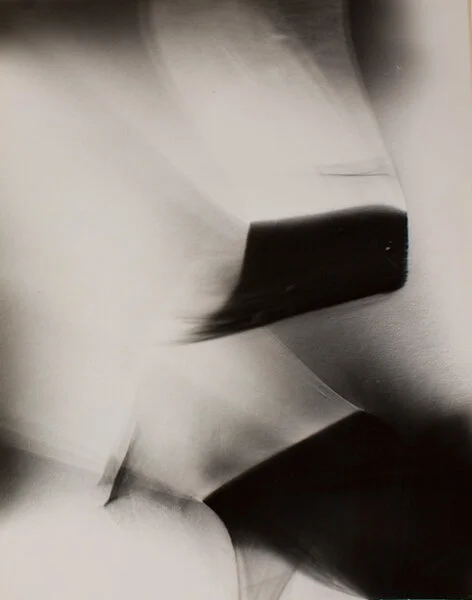Lotte Jacobi (born Johanna Alexandra Jacobi Reiss)
German, b. West Prussia, 1896 - d. 1990, New Hampshire, USA
Photogenic
1946, gelatin silver print, 12.5 x 11in.
Lotte Jacobi, Photogenic, 1946, gelatin silver print, 12.5 x 11 (in.), BMC. Gift of Seymour Adelman PA.1983.2.1
Lotte Jacobi’s Photogenic is in its essence an abstract study of light. Undefined shapes of black and white sweep across the paper, leaving traces of their motion in space behind as trailing shadows and sweeps of light. There is no object, only the shadows of the presence of an object. At the center a rectangular form of black crosses the white page, falling towards the right corner where a larger black mass sits, drawing the viewer’s attention down. Central to the work are the subtleties of black-white contrast, highlighting stark differences and softening harsh edges and lines into grays, blurring the space. The contrasts have apparently been swapped from convention; black rises to the focus, with white taking on the role of background.
Jacobi, best known for her portraiture, was born into a long line of photographers; her great-grand father visited Paris between 1839 and 1842, where he obtained a camera, a license, and some instruction from Daguerre himself [1]. In 1935, with the Nazi rise to power, Jacobi, an already established photographer of major cultural figures, and of dance and theatre in Weimar Berlin, was forced to flee Germany, settling in New York. As her surroundings changed, so did her work. In the mid 1940s she began to make abstract images, taking the quality of light and movement perfected in her portraiture and applying it directly to the paper. Called ‘photogenics,’ Jacobi produced the images through exposing photosensitive paper to light, utilizing pieces of glass or twisted cellophane to interrupt the beans from a small flashlight positioned above photographic paper, creating the dark shapes seen on Bryn Mawr’s Photogenic. The images that appear are the result of gestures, as the traces of objects without a physical presence.* A direct contact with the photosensitive paper is preserved.
“If I could, I would do nothing but these photogenics from now on. I can do what I want in them. I wanted to make a bird form and I know that I can.” [2] Lotte Jacobi
These are deeply experimental works of non-objective photography. Leo Katz, who first applied the term ‘photogenics’ to Jacobi’s work, wrote of non-objective photography: “instead of a brush one handles a light source, and instead of the canvas one uses a photosensitive surface. Thus the procedure [of photography] is no longer selective but inventive.” [3] This practice is an intervention of the very act of photography. It can be spoken of along the lines of a Dadaist commentary on art and art making practices. It can at the same time be viewed in opposition to the classical understanding of Duchamp’s Dada , in which artistic control was in part surrendered, with the selection of an object taking precedence. Where Duchamp used selection as a rejection of painterly creation, so did Jacobi use creation as a rejection of photographic selection, thus functioning in the same vein of subversion of process and medium.
What does it mean for a